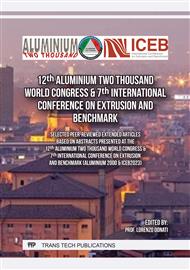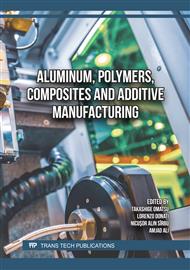[1]
T. Furu and O. R. Myhr, "Method for the Optimization of Product Properties and Production Cost of Industrial Process," (2014).
Google Scholar
[2]
O. R. Myhr, R. Østhus, J. Søreide and T. Furu, "A Novel Methodology for Optimization of Properties, Cost and Sustainability of Aluminium Extrusions," in ET2016, Orlando, (2016).
DOI: 10.4028/www.scientific.net/msf.877.625
Google Scholar
[3]
T. Furu, R. Østhus and O. R. Myhr, "A Digital Twin for Production of Aluminium Extrusions," in ET2020, Orlando, (2022).
Google Scholar
[4]
Hydro, "Aluminium Recycling," [Online]. Available: https://www.hydro.com/en-NO/aluminium/about-aluminium/aluminium-recycling/.
Google Scholar
[5]
B. Reggiani, L. Donati and L. Tomesani, "Multi-goal optimization of industrial extrusion dies by means of meta-models," The International Journal of Advanced Manufacturing Technology, vol. 88, 2017.
Google Scholar
[6]
R. Pelaccia, M. Negozio and B. D. L. Reggiani, "Assessment of the Optimization Strategy for Nitrogen Cooling Channel Design in Extrusion Dies," Key Engineering Materials, vol. 926, 2022.
DOI: 10.4028/p-f7i0y2
Google Scholar
[7]
G. Zhao, H. Chen, C. Zhang and Y. Guan, "Multiobjective optimization design of porthole extrusion die using Pareto-based genetic," The International Journal of Advanced Manufacturing Technology, vol. 69, 2013.
DOI: 10.1007/s00170-013-5124-5
Google Scholar
[8]
N. Lebaal, F. Schmidt and S. Puissant, "Design and optimization of three-dimensional extrusion dies, using constraint optimization algorithm," Finite Element in Analysis and Design, vol. 45, no. 5, pp.333-340, 2009.
DOI: 10.1016/j.finel.2008.10.008
Google Scholar
[9]
Z. Lin, X. Juchen, W. Xinyun and H. Guoan, "Optimization of die profile for improving die life in the hot extrusion process," Journal of Materials Processing Technology, vol. 142, pp.659-664, 2003.
DOI: 10.1016/s0924-0136(03)00686-1
Google Scholar
[10]
S. T. Wang, R. S. Lee, H. Y. Li and C. H. Chen, "Optimal Die Design for Three-Dimensional Porthole Extrusion Using the Taguchi Method," IMechE, vol. 220, pp.1005-1009, 2006.
Google Scholar
[11]
F. Gagliardi, G. Ambrogio, C. Ciancio and L. Filice, "Metamodeling technique for designing reengineered processes by historical data," Journal of Manufacturing Systems, vol. 45, 2017.
DOI: 10.1016/j.jmsy.2017.09.004
Google Scholar
[12]
S. Jajimoggala, N. Murali Krishna and K. Syed, "Selection of optimal hot extrusion process parameters for AA6061using hybrid MCDM technique," Materials Today: Proceedings, vol. 18, pp.278-290, 2019.
DOI: 10.1016/j.matpr.2019.06.302
Google Scholar
[13]
J. Blank and K. Deb, "pymoo: Multi-Objective Optimization in Python," doi: 10.1109/ACCESS.2020.2990567, pp.89497-89509, (2020).
DOI: 10.1109/access.2020.2990567
Google Scholar
[14]
IMPETUS Afea Solver®, IMPETUS Afea AS.
Google Scholar
[15]
O. R. Myhr, Ø. Grong and C. Schäfer, Metall. Mater. Trans A, vol. 46A, p.6018, (2015).
Google Scholar
[16]
O. R. Myhr, Ø. Grong and K. O. Pedersen, Metall. Mater. Trans A, vol. 41A, p.2276, (2010).
Google Scholar
[17]
O. R. Myhr, O. S. Hoppestad and T. Børvik, Metall. Mater. Trans A, vol. 49A, p.3592, (2018).
Google Scholar
[18]
M. Iddberg, O. R. Myhr, A. Nesse and T. Furu, A Modelling Framework for Rapid Evaluation of Speed Limiations of Aluminium Profiles, Aluminium 2000, (2023).
Google Scholar
[19]
Environmental Metrics Report, International Aluminium Institute, (2014).
Google Scholar
[20]
K. Deb, A. Pratap, S. Agarwal and T. Meyarivan, A fast and elitist multiobjective genetic algorithm: NSGA-II, IEEE Transactions on Evolutionary Computation, (2002).
DOI: 10.1109/4235.996017
Google Scholar
[21]
Addendum 57: UN Regulation No. 58.
Google Scholar



